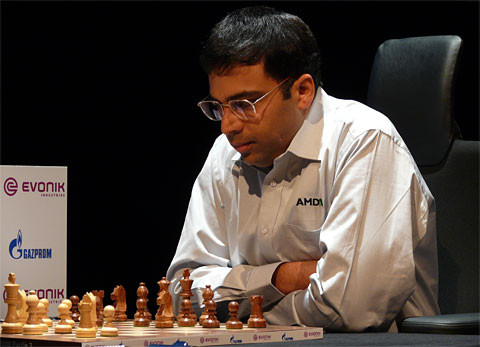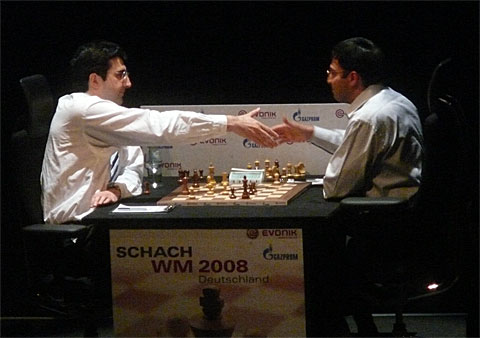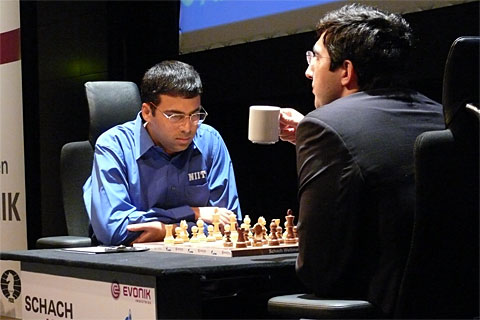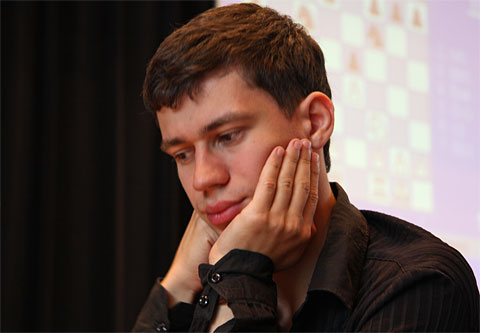| Latest | Greatest | Lobby | Journals | Search | Options | Help | Login |
|
|
|
This topic is archived. |
| Home » Discuss » Topic Forums » Sports |
|
| Jack Rabbit
|
Sat Oct-18-08 05:47 PM Original message |
| The Jack Rabbit Chess Report (October 18): Anand draws first blood; Three tie in Russian Chmpnship |
|
Anand Draws First Blood; Leads Kramnik after Four Rounds
  Current world champion Vishy Anand of India drew first blood against his predecessor, Russian GM Vladimir Kramnik, in the third round of their world championship match in Bonn yesterday. Today's fourth round game, like the first two games of the match, ended in a draw, giving Anand a 2�-1� edge toward his title defense. Kramnik will attempt to regain the title he lost in Mexico City last year when Anand won a championship tournament of eight of the strongest players in the world. Kramnik had held the title since the Autumn of 2000, when he defeated the great Garry Kasparov in a fourteen-game match in London. Kramnik underscored his right to the title in 2006 when he narrowly defeated Bulgaria's Veselin Topalov, who held FIDE's version of the world championship after winning a strong tournament in San Luis, Argentina. That ended a long schism in chess in which two champions claimed the title simultaneously for 13 years. Anand, one of the most popular players in the world, played Kasparov for the title in 1995 in New York, losing a scheduled 20-game match in 18 games, 10�-7�; Kasparov won four games to Anand's one. Since that time, Anand remained one of the two or three top ranked grandmasters in the game. He is the first world champion of Asian heritage. The winner of the match will play against the winner of a match between Topalov and US grandmaster Gata Kamsky to be held in Ukraine in December. The fifth game of the match will be held Monday. The twelfth and final round will be played October 31 with November 2 being set aside for playoffs in the event of a tied match. Superfinal Ends in Three-Way Tie in Moscow  The "Superfinal" of the Russian National Championship ended Wednesday in Moscow in a three-way tie among four-time former champion Peter Svidler, former champion Evgeny Alekseev and Dmitry Jakovenko. Each player scored 7 points in 11 rounds. They were followed by defending champion Alexander Morozevich, Nikita Vitiugov and Evgeny Tomashevsky in a three-way tie for fourth place at 6� points. The last three rounds were a wild scramble at the top, percepitated by Artyom Timofeev's miniature defeat of Svidler in the ninth round. That yanked Svidler out of first place, where he was replaced with Timofeev and Jakovenko with 6 points each. In the tenth round, Alekseev took sole possesion of first place by defeating Konstantin Sakaev in 59 moves. Meanwhile, Vitiugov moved into second place with 6� points by defeating Timofeev in 64 moves. Vitiugov was the only player with any chance of overtaking Alekseev in the final round. Timofeev, Jakovenko and Svidler were in third place with six points with the possibility of catching but not surpassing Alekseev. In the final round, Alekseev, playing White, fell to Svidler in 34 moves while Jakovenko, also playing White, ended Vitiugov's hope by dispatching him in just 30 moves. Timofeev's bid to make it a four-way tie at at the top were dashed on the rocks by Tomashevsky in 58 moves. A six-round rapid playoff will take place among the first place finishers on Tuesday, October 28. While a two-way playoff would have been appended to Wednesday schedule, a three way playoff is much more complicated and would not have ended until 1 am. European Club Cup Begins in Greece  The annual European Team Championship, also called the European Club Cup, began yesterday in Kallithea on the Isthmus of Corinth in Greece. After two rounds Sverdlovsk and Saransk, both Russian teams, lead the 63-team general competition. The women's competition is led by Radnicki Rudovci, a team from Serbia. The seven-round event lasts through Thursday. Calendar Asian Championships, Tehran 21-30 October. Chess Olympiad, Dresden 12-25 November. Pan-American Championship, Boca Raton, Florida 1-7 November. Topalov-Kamsky World Championship Semifinal Match, Lvov 26 November-15 December. Eight Rounds. FIDE Grand Prix, Doha 13-29 December. Hasting Chess Tournament 28 December 2008-5 January 2009. Rilton Cup, Stockholm 28 December 2008-5 January 2009. Corus Chess Tournament, Wijk aan Zee 16 January-1 February 2009. |
| Printer Friendly | Permalink | | Top |
| Jack Rabbit
|
Sat Oct-18-08 05:48 PM Response to Original message |
| 1. Match for the World Title, Bonn |
|
Your humble hare acknowledges the assistance of Fritz 6.0 on analysis. Diagrams on the Jack Rabbit Chess Report are made with Chess M�rida, a true type font that can be downlaoded free here. !""""""""# $tMvWlVmT% $OoOoOoOo% $ + + + +% $+ + + + % $ + + + +% $+ + + + % $pPpPpPpP% $RnBqKbNr% /(((((((() WHITE White to move (This position is a theoretical draw) |
| Printer Friendly | Permalink | | Top |
| Jack Rabbit
|
Sat Oct-18-08 05:52 PM Response to Reply #1 |
| 2. Round 3 (Kramnik 0-1 Anand) |
 Vishy Anand Vladimir Kramnik - Vishy Anand Match for the World Title, Round 3 Bonn, 17 October 2008 Semi-Slav Queen's Gambit: Meran Defense (Reynolds Opening) 1.d4 d5 2.c4 c6 3.Nf3 Nf6 4.Nc3 e6 5.e3 Nbd7 6.Bd3 dxc4 7.Bxc4 b5 8.Bd3 a6
9.e4
9...c5 10.e5 10...cxd4 11.Nxb5 axb5 12.exf6 gxf6
13.0-0 Qb6 14.Qe2 Bb7!?
15.Bxb5
15...Bd6
16.Rd1 Rg8 17.g3
17...Rg4 18.Bf4?!
!""""""""# $t+ +l+ +% $+v+m+o+o% $ W VoO +% $+b+ + + % $ + O Bt+% $+ + +nP % $pP +qP P% $R +r+ K % /(((((((() WHITE: Vladimir Kramnik Position after 18.Bc1f4 18...Bxf4!
19.Nxd4 h5
20.Nxe6
20...fxe6 21.Rxd7 Kf8 22.Qd3 !""""""""# $t+ + L +% $+v+r+ + % $ W +oO +% $+b+ + +o% $ + + Vr+% $+ +q+ P % $pP + P P% $R + + K % /(((((((() WHITE: Vladimir Kramnik Position after 22.Qe2d3 22...Rg7!!
23.Rxg7
23...Kxg7 24.gxf4
24...Rd8 25.Qe2
25...Kh6 26.Kf1 Rg8 27.a4?
27...Bg2+ 28.Ke1 Bh3 29.Ra3
29...Rg1+ 30.Kd2 Qd4+ 31.Kc2
31...Bg4!
32.f3
32...Bf5+ 33.Bd3
33...Bh3
34.a5
34...Rg2 35.a6
35...Rxe2+
36.Bxe2 Bf5+ 37.Kb3 Qe3+ 38.Ka2 Qxe2 39.a7 Qc4+ 40.Ka1 Qf1+ 41.Ka2 Bb1+ 0-1
 Kramnik resigns to Anand to end Round 3 |
| Printer Friendly | Permalink | | Top |
| Jack Rabbit
|
Sat Oct-18-08 05:56 PM Response to Reply #1 |
| 3. Round 2 (Anand �-� Kramnik) |
 Anand and Kramnik at the start of the action in Game 2 Vishy Anand - Vladimir Kramnik Match for the World Title, Round 2 Bonn, 15 October 2008 East India Game: Nimzo-Indian Defense (S�misch Opening/Lilienthal Variation) 1.d4 Nf6 2.c4 e6 3.Nc3 Bb4 4.f3 d5 5.a3 Bxc3+ 6.bxc3
6...c5 7.cxd5 Nxd5 8.dxc5 f5
9.Qc2
9...Nd7
10.e4 fxe4 11.fxe4 N5f6 12.c6 bxc6 13.Nf3 Qa5!?
14.Bd2
14...Ba6
15.c4
15...Qc5 16.Bd3 Ng4
17.Bb4?!
17...Qe3+!
18.Qe2 0-0-0?!
19.Qxe3 Nxe3 20.Kf2 Ng4+
!""""""""# $ +lT + T% $O +m+ Oo% $v+o+o+ +% $+ + + + % $ Bp+p+m+% $P +b+n+ % $ + + KpP% $R + + +r% /(((((((() WHITE: Vishy Anand Position after 20...Ne3g4+ 21.Kg3!
21...Ndf6
22.Bb1 h5 23.h3
23...h4+ 24.Nxh4 Ne5
25.Nf3 Nh5+
26.Kf2 Nxf3 !""""""""# $ +lT + T% $O + + O % $v+o+o+ +% $+ + + +m% $ Bp+p+ +% $P + +m+p% $ + + Kp+% $Rb+ + +r% /(((((((() WHITE: Vishy Anand Position after 26...Ne5f3:N 27.Kxf3!
27...e5 28.Rc1
28...Nf4 29.Ra2 Nd3 30.Rc3 Nf4 31.Bc2
31...Ne6 32.Kg3 Rd4 �-�
|
| Printer Friendly | Permalink | | Top |
| Jack Rabbit
|
Sat Oct-18-08 06:02 PM Response to Original message |
| 4. Russian National Championship |
|
Your humble hare acknowledges the assistance of Fritz 6.0 on analysis. Diagrams on the Jack Rabbit Chess Report are made with Chess M�rida, a true type font that can be downlaoded free here. !""""""""# $tMvWlVmT% $OoOoOoOo% $ + + + +% $+ + + + % $ + + + +% $+ + + + % $pPpPpPpP% $RnBqKbNr% /(((((((() WHITE White to move (This position is a theoretical draw) |
| Printer Friendly | Permalink | | Top |
| Jack Rabbit
|
Sat Oct-18-08 06:03 PM Response to Reply #4 |
| 5. Tomofeev - Maslak, Round 7, Moscow |
 Artyom Timofeev {link:|Artyom Timofeev - Konstantin Maslak] Russian National Championship, Round 7 Moscow, 10 October 2008 Symmetrical English Game: Four Knights' Opening (Catalan Variation) 1.c4 Nf6 2.Nc3 g6 3.g3 c5 4.Bg2 Bg7 5.Nf3 Nc6 6.0-0 0-0 7.d4 cxd4
8.Nxd4 d6
9.Nc2
9...a6
10.b3 Qa5
11.Nd5!?
!""""""""# $t+b+ Tl+% $+o+ OoVo% $o+mO Mo+% $W +n+ + % $ +p+ + +% $+p+ + P % $p+n+pPbP% $R Bq+rK % /(((((((() WHITE: Artyom Timofeev Position after 11.Nc3d5 11...Be6?
12.Bd2 Qd8 13.Rc1 Rc8 14.Nce3
14...Re8 15.Bc3 Ng4
16.Nxg4!
16...Bxg4 17.Bxg7 Kxg7 18.Qd2 Bd7
19.Rfd1 b6
20.b4 e5
21.Qe3 Rb8 22.b5
22...axb5 23.cxb5 Nd4
!""""""""# $ T Wt+ +% $+ +v+oKo% $ O O +o+% $+p+mO + % $ + M + +% $+ + Q P % $p+ +pPbP% $+ Rr+ K % /(((((((() WHITE: Artyom Timofeev Position after 23...Nc6d4 24.Rxd4!!
24...exd4 25.Qxd4+ f6 26.e3
26...Rf8 27.a4 Be8
28.h4 Rf7 29.Bh3
29...Bd7
30.Bxd7 Rxd7
31.Rc6 Rc8
32.Rxc8 Qxc8 33.Nxf6
33...Qc1+
34.Kg2 Rf7 35.Ng4+ 1-0
|
| Printer Friendly | Permalink | | Top |
| Jack Rabbit
|
Sat Oct-18-08 06:07 PM Response to Reply #4 |
| 6. Sakaev - Alekseev, Round 10, Moscow |
 Evgeny Alekseev Konstantin Sakaev - Evgeny Alekseev Russian National Championship, Round 10 Moscow, 14 October 2008 East India Game: Nimzo-Indian Defense (Zurich Opening) 1.d4 Nf6 2.c4 e6 3.Nc3 Bb4 4.Qc2 0-0 5.a3 Bxc3+ 6.Qxc3 d6
7.Nf3
7...b6 8.g3 Bb7 9.Bg2 Nbd7 10.0-0 Qe7 11.b3
11...c5
12.Bb2 Rac8
13.d5?!
13...Rfe8?!
14.dxe6
14...fxe6 15.Qd2
15...d5 16.Ne1
16...Bc6 17.Nd3
17...dxc4 18.bxc4 Bxg2 19.Kxg2 e5
20.Qc2 Qd6
21.Rad1 Nb8?!
22.f3?!
22...Qc7
23.Nf2 Nc6 24.e3 Rcd8
25.Ne4
25...Na5
26.Nxf6+ gxf6 27.Rd5 !""""""""# $ + Tt+l+% $O W + +o% $ O + O +% $M OrO + % $ +p+ + +% $P + PpP % $ Bq+ +kP% $+ + +r+ % /(((((((() WHITE: Konstantin Sakaev Position after 27.Rd1d5 27...Rxd5!
28.cxd5 b5 29.e4 Nc4 30.Bc1
30...Nd6
31.Be3
31...Rc8 32.f4 Qg7
33.fxe5
33...fxe5 34.Bc1 Qg4!?
35.Re1?!
!""""""""# $ +t+ +l+% $O + + +o% $ + M + +% $+oOpO + % $ + +p+w+% $P + + P % $ +q+ +kP% $+ B R + % /(((((((() WHITE: Konstantin Sakaev Position after 35.Rf1e1 35...Rf8!
36.Qe2 Qxe2+ 37.Rxe2 a5!?
38.Bb2 Nc4 39.Bc1
39...b4
40.Rc2 Nd6 41.Rxc5 b3 42.Kh3?
42...a4 43.Bb2 Nxe4 44.Rc7
!""""""""# $ + + Tl+% $+ R + +o% $ + + + +% $+ +pO + % $o+ +m+ +% $Po+ + Pk% $ B + + P% $+ + + + % /(((((((() WHITE: Konstantin Sakaev Position after 44.Rc5c7 44...Nf2+!
45.Kh4 Nd3 46.Bc3 Rd8 47.Kg5 Rxd5 48.Kf6
48...Rd6+ 49.Kf5 Rb6 50.Rc8+ Kf7 51.Rc7+ Kf8
52.Ke4 b2 53.Bxb2 Nxb2 54.Rxh7 Nc4
55.Ra7 Rd6
56.Kf5 Rd4 57.Kf6
57...Ke8 58.h4
58...e4 59.h5 e3 0-1
|
| Printer Friendly | Permalink | | Top |
| Jack Rabbit
|
Sat Oct-18-08 06:12 PM Response to Reply #4 |
| 7. Vitiugov - Timofeev, Round 10, Moscow |
 Nikita Vitiugov Nikita Vitiugov - Artyom Timofeev Russian National Championship, Round 10 Moscow, 14 October 2008 Hollander Game: Dutch Queen's Gambit (Stonewall Defense) 1.Nf3 d5 2.d4 e6 3.c4 c6 4.e3 Bd6 5.Nc3 f5 6.Ne5
6...Nf6 7.Be2 0-0 8.0-0 b6
9.Qc2!?
9...Ba6
10.f4 Qe7 11.b3
11...Bb7
12.a3 Nbd7 13.b4 c5
14.bxc5
14...bxc5 15.Rb1 Nb6 16.Nb5 Bxe5
17.dxe5 Ne4 18.cxd5
18...Bxd5 19.a4
19...Bc6 20.Bf3 Nxa4 21.Ba3 Rfb8?!
22.Bxe4!
22...Bxe4 !""""""""# $tT + +l+% $O + W Oo% $ + +o+ +% $+nO Po+ % $m+ +vP +% $V + P + % $ +q+ +pP% $+r+ +rK % /(((((((() WHITE: Nikita Vitiugov Position after 22...Bc6e4:B 23.Qxa4!!
23...Bxb1 24.Rxb1
24...Qd7
25.Rd1 Qc6 26.Nc3 Qxa4
27.Nxa4 c4 28.Nc5!
28...Rb6
29.Kf2 Rc8 30.Rc1 Kf7?
31.Ke2 Rb5
32.Rxc4
32...Ra5
!""""""""# $ +t+ + +% $+ + +lOo% $ + +o+ +% $T N Po+ % $ +r+ P +% $B + P + % $ + +k+ +% $+ + + + % /(((((((() WHITE: Nikita Vitiugov Position after 32...Rb5a5 33.Nb7!
33...Rxc4 34.Nd6+ Kg6 35.Nxc4 Rb5
36.Nd2
36...Ra5 37.Nc4 Rb5 38.Kd2 Rb1 39.Bc1
39...h6 40.Kc2 Rb4 41.Na5 Kf7
42.Bd2 Rb8
43.Nb3 g5 44.Nd4 gxf4
!""""""""# $ T + + +% $P + +l+ % $ + +o+ O% $+ + Po+ % $ + N O +% $+ + P + % $ +kB +oO% $+ + + + % /(((((((() WHITE: Nikita Vitiugov Position after 44...gf4:p 45.exf4!
45...h5 46.g3 Rb6
47.Ba5 Rb8 48.Bc3 Rb6 49.Nb3 Rb5
50.Nd2 Rc5 51.Kb3 Ke8
52.Kb4 Rd5 53.Kc4 Kd7 54.Bd4
54...Ra5 55.Bc3
55...Rd5 56.h4 Ke8 57.Nf3 Rd8
!""""""""# $ + Tl+ +% $O + + + % $ + +o+ +% $+ + Po+o% $ +k+ P P% $+ B +nP % $ + + + +% $+ + + + % /(((((((() WHITE: Nikita Vitiugov Position after 57...Rd5d8 58.Ng5!
58...Rc8+ 59.Kd3 Ke7
60.Bb4+ Kd7 61.Nh7 Kc6
62.Nf8 a5 63.Bd6 Kd5 64.Ng6 1-0
|
| Printer Friendly | Permalink | | Top |
| Jack Rabbit
|
Sat Oct-18-08 06:15 PM Response to Reply #4 |
| 8. Alekseev - Svidler, Round 11, Moscow |
 Peter Svidler Alekseev - Peter Svidler Russian National Championship, Round 11 Moscow, 15 October 2008 Closed German Game: Short Opening (Caro-Kann Defense) 1.e4 c6 2.d4 d5 3.e5 Bf5 4.Nf3 e6 5.Be2 Nd7 6.0-0 Bg6 7.b3
7...Nh6 8.c4 Nf5 9.Nc3
9...Bb4 10.Bb2
10...0-0 11.Bd3!?
11...f6
12.Ne2
12...fxe5
13.dxe5 Nc5 14.Nf4 Nxd3
15.Nxd3 Bh5 16.Nf4 Bxf3
17.Qxf3 Qe7 18.cxd5!?
18...cxd5
19.Qg4
19...Bd2 20.Nd3 Rac8
21.Qd1?
21...Qg5!
22.g3 Be3 23.Kh1
23...Qh6
24.Bc1 d4?
25.Kg2?
!""""""""# $ +t+ Tl+% $Oo+ + Oo% $ + +o+ W% $+ + Pm+ % $ + O + +% $+p+nV P % $p+ + PkP% $R Bq+r+ % /(((((((() WHITE: Evgeny Alekseev Position after 25.Kh1g2 25...Rc3!
26.Qe2 Qg6?
27.fxe3!
27...Rxd3 28.Kg1 Nxe3
29.Rxf8+ Kxf8 30.Bxe3 dxe3
31.Rc1 h6 32.Rc8+ Kf7 33.g4?
!""""""""# $ +r+ + +% $Oo+ +lO % $ + +o+wO% $+ + P + % $ + + +p+% $+p+tO + % $p+ +q+ P% $+ + + K % /(((((((() WHITE: Evgeny Alekseev Position after 33.g3g4 33...Qe4!
34.Rc4 Qd5 0-1
|
| Printer Friendly | Permalink | | Top |
| Jack Rabbit
|
Sat Oct-18-08 06:17 PM Response to Reply #4 |
| 9. Jakovenko - Vitiugov, Round 11, Moscow |
|
Dmitry Jakovenko Dmitry Jakovenko - Nikita Vitiugov Russian National Championship, Round 11 Moscow, 15 October 2008 Closed French Game: Steinitz Opening 1.e4 e6 2.d4 d5 3.Nc3 Nf6 4.e5 Nfd7 5.f4 c5 6.Nf3 Nc6 7.Be3 a6
8.Qd2 b5 9.a3
9...Bb7 10.Bd3 g5!?
11.fxg5
11...cxd4 12.Nxd4
12...Ndxe5 13.0-0 Bg7 14.Nxc6
14...Bxc6 15.Bc5!?
15...Qc7
16.a4!?
16...Nc4
17.Qf2
17...b4
18.Bxb4
18...Nxb2 !""""""""# $t+ +l+ T% $+ W +oVo% $o+v+o+ +% $+ +o+ P % $pB + + +% $+ Nb+ + % $ Mp+ QpP% $R + +rK % /(((((((() WHITE: Dmitry Jakovenko Position after 18...Nc4b2:p 19.Rab1!
19...Nxd3 20.cxd3 Be5 21.Rbc1
21...Rb8 22.Na2 Rb7
23.Qc2 Bd7 24.Qf2 Bc6 25.Rc2!
25...a5?
26.Rfc1!
26...axb4 27.Rxc6 Qa5
!""""""""# $ + +l+ T% $+t+ +o+o% $ + +o+ +% $W +oV P % $pO + + +% $+ +p+ + % $n+ + QpP% $+ R + K % /(((((((() WHITE: Dmitry Jakovenko Position after (move) 28.R6c5!
28...Qa7
29.Nxb4 Bc7 30.Rxc7 1-0
|
| Printer Friendly | Permalink | | Top |
| Jack Rabbit
|
Mon Oct-20-08 02:40 PM Response to Original message |
| 10. Update (Monday): Vishy takes Game 5 in Bonn |
|
World chammpion Vishy Anand won for the second time in the last three rounds to take a two point lead against former champion Vladimir Kramnik in the fifth game of their 12-game title match in Bonn today.
Anand, playing Black, defended against Kramnik's Queen's pawn opening with the sharp Meran Defense, which he also used to win the third game on Saturday. The sixth round, with Anand playing White, will be played tomorrow starting at 15:00 Central Europe Daylight Time (6 am PDT). |
| Printer Friendly | Permalink | | Top |
| Jack Rabbit
|
Tue Oct-21-08 12:39 PM Response to Original message |
| 11. Update (Tuesday): Anand wins game 6, Victory is near |
|
World champion Vishy Anand defeated challenger and former worild champion Vladimir Kramnik a few minutes ago in the sixth game of their world title match in Bonn.
The win gives Anand a 4�-1� lead in the match at the half-way point. Few observers believe that even a player of Kramnik's prowess can overcome a three-point deficit in just six games. The winner of the match is the first player to score 6� points. Anand played White and again opened with 1.d4, as he has in his other two White games in the match. Kramnik adopted a variation of the Orthodox Queen's Gambit known as the Ragozin Defense, which is akin the the Nimzo-Indian that has brought Anand two points with Black so far in the match. The game lasted 47 moves and was the first White vicotry of the match. The players have tomorrow off and will resume the second half of the match with Anand having White in the seventh round on Thursday. |
| Printer Friendly | Permalink | | Top |
| DU
AdBot (1000+ posts) |
Tue Apr 30th 2024, 06:02 PM Response to Original message |
| Advertisements [?] |
| Top |
| Home » Discuss » Topic Forums » Sports |
|
Powered by DCForum+ Version 1.1 Copyright 1997-2002 DCScripts.com
Software has been extensively modified by the DU administrators
Important Notices: By participating on this discussion board, visitors agree to abide by the rules outlined on our Rules page. Messages posted on the Democratic Underground Discussion Forums are the opinions of the individuals who post them, and do not necessarily represent the opinions of Democratic Underground, LLC.
Home | Discussion Forums | Journals | Store | Donate
About DU | Contact Us | Privacy Policy
Got a message for Democratic Underground? Click here to send us a message.
© 2001 - 2011 Democratic Underground, LLC